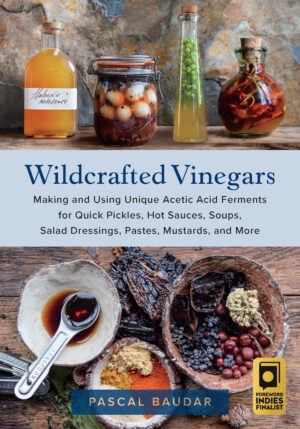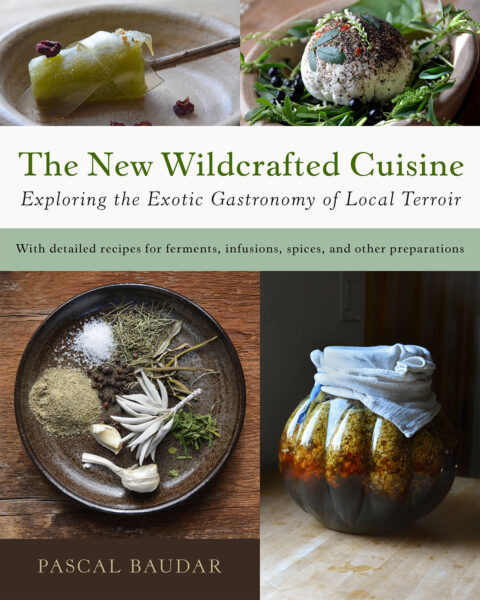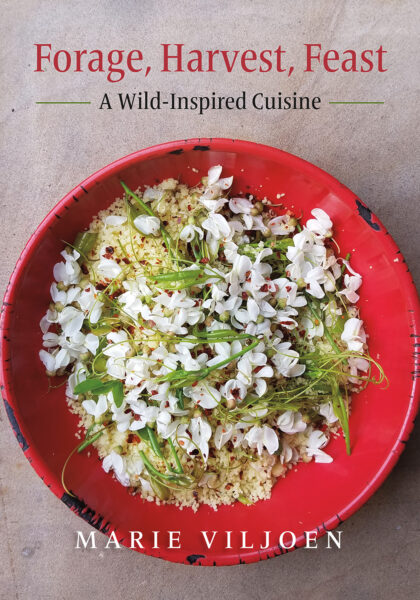Vinegar in Soup: The Soup-er Secret Ingredient
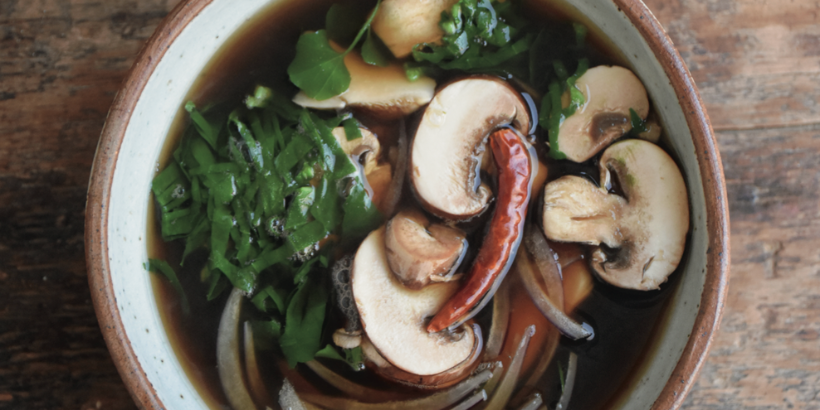
Move aside, chicken noodle and tomato bisque! We’re trying out some new soups with one ingredient in common: vinegar. Flavorful and unique, these recipes will have you including vinegar in soup for years to come.
The following is an excerpt from Wildcrafted Vinegars by Pascal Baudar. It has been adapted for the web.
Adding Vinegar in Soup
It may sound a bit strange and unusual for some, but vinegar is a common ingredient in some soup recipes, and there is a good reason for it.
If you think about it, vinegar is really a flavor-enhancer (umami). That’s why it is so often used in cooking, sauces, and salad dressings. The same is true with soups.
Some good examples are the classic Chinese sweet, hot, and sour soups and sauces, but you’ll find vinegar used in recipes from numerous other countries and cultures, as well.
So, a big YES to vinegars in soups! To be honest, this was kind of a new concept for me before working on this book, but these days I often use vinegar in my wild food soups.
In this book, I want to share a very, very basic vinegar soup stock recipe that anyone can make. With it, I’m able to make a comforting soup in minutes using the plants from any hike. The secret code for this soup stock is 1.1.1.
1.1.1. Soups
The simple soup stock is composed of:
- 1 cup (240 ml) soup stock or water (boiling hot)
- 1 tablespoon (15 ml) soy sauce
- 1 tablespoon (15 ml) vinegar (spicy ones are the best!)
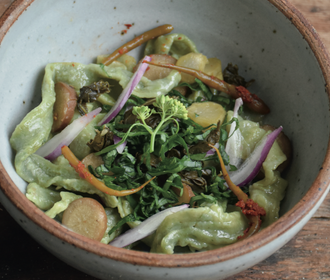 That’s it. Now of course, it’s much better with a good soup stock (plant-based or not), but even water works.
That’s it. Now of course, it’s much better with a good soup stock (plant-based or not), but even water works.
If you only have water, maybe add a teaspoon of blended herbs and fresh onion/garlic in the bowl, but water alone will still be okay.
Vinegar in Soup: The Creative Possibilities
You have tons of creative possibilities. The vinegar can be homemade and spicy (like Tabasco), for example, but what you put in the bowl is also endlessly creative.
Go on a hike, pick some of your favorite wild edibles, and use them alongside regular savory ingredients such as garlic, onion, chili peppers, and so on.
For the soup in the photo I used fermented burdock roots, pickled radish pods, nettles pasta, minced black mustard leaves, sliced red onion, garlic, and 1⁄2 teaspoon (1.5 g) of Italian herbs.
I like to cut the wild greens in small strips (chiffonade) so that even tough leaves become edible.
Perfect Recipes for Foragers
So seriously, try it. . . . I think you’ll love it. It’s perfect for foragers who can collect various savory plants to make something quick and delicious, but it obviously works with store-bought ingredients, too.
If you’re a fermenter, you can add some of your favorite savory ferments like I did with the fermented burdock roots.
Oh…and seaweed! Seaweed with sliced red onions and tofu . . . so good!
If it’s too salty for you, reduce the amount of soy sauce. And try a good spicy vinegar or a vinegar-based hot sauce like Tabasco. Such a nice balance. If you use Tabasco, make it half regular cider vinegar and half Tabasco, otherwise it might be too spicy.
The following 2 recipes are examples to show the versatility.
RECIPE: Mixed Seasonal Wild Greens and Mushrooms Soup
With this kind of soup (1.1.1.), you can easily take advantage of what’s in season in your environment. In Southern California I’ve always found wild greens I could use at any time of the year, such as watercress, chickweed, wild mustard leaves, miner’s lettuce, and so on.
Even during the winter, I was able to use young mustard or wild radish sprouts.
In this recipe I’m using commercial baby bella mushrooms. If you use foraged mushrooms, make sure to cook them first. Some wild mushrooms, such as morels, can be toxic if they are eaten raw or not fully cooked.
Ingredients for 1 large bowl (240 ml)
- 1 1⁄2 cups (360 ml) soup stock or water
- 1⁄4 onion, slice
- 2 tablespoons (7 g) chopped wild greens 11⁄2 tablespoons (23 ml) soy sauce
- 1 1⁄2 tablespoons (23 ml) homemade vinegar of your choice or apple cider vinegar
- 1 baby bella mushroom, sliced
- 1 dry chili pepper
- 1⁄2 garlic clove, minced
Procedure
- Place a pot containing the soup stock over high heat and bring to a boil.
- Meanwhile, place all the remaining ingredients into a bowl. If you use wild mushrooms, make sure to cook them first.
- Pour the boiling stock over the ingredients and wait 5 or 6 minutes before serving. If you want to keep the soup very warm, you can place a plate on top of the bowl.
This kind of soup is quick and easy to make, which was perfect for my classes. We were able to do a wild food walk, collect wild greens, and make a soup on the spot.
RECIPE: Wild Radish Roots Soup
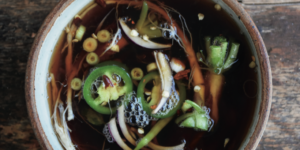 This is another example of the versatility of the 1.1.1 soup. You’re not stuck using just common wild greens and mushrooms.
This is another example of the versatility of the 1.1.1 soup. You’re not stuck using just common wild greens and mushrooms.
There are all kinds of savory or nutritious ingredients that can be added, such as roots, seeds and grains, edible flowers, and even insects.
I used to have a small mealworm “farm” in my apartment and would sometimes add dehydrated mealworms to my soups as a source of protein and nutty flavor.
The Brassica family has a lot of edible roots. Personally, I’ve used wild radish, black mustard, and Mediterranean mustard roots to make this kind of soup.
Realize that timing is important, as a lot of the wild Brassica roots become tough and fibrous over time. Feel free to create other soups around this basic recipe by adding ingredients from your own terroir.
Ingredients for 1 large bowl (240 ml)
- 11⁄2 cups (360 ml) soup stock or water 1⁄4 onion, sliced
- 2 to 3 wild radish pods
- 3 to 4 small and tender wild radish or mustard roots
- 1 1⁄2 tablespoons (23 ml) soy sauce
- 1 1⁄2 tablespoons (23 ml) homemade vinegar of your choice or apple cider vinegar
- 1⁄2 jalapeño, sliced
- 1⁄2 garlic clove, minced
- 1 teaspoon (4 g) wild oat grains (I cook them well in advance and freeze them)
- 1 teaspoon (1.9 g) sliced black mustard stems
Procedure
- Place a pot containing the soup stock over high heat and bring to a boil. Meanwhile, place all the remaining ingredients into a bowl.
- Pour the boiling water over the ingredients and wait 5 or 6 minutes before serving. If you want to keep the soup very warm, you can place a plate on top of the bowl.
Recommended Reads
The Vibrance of Vinegar: Methods to Make Vinegar From Scratch
Recent Articles
Chances are, you’ve seen cattails growing on the edge of your local lake or stream at least once or twice. Instead of just passing these plants, try foraging for and cooking them to create delicious seasonal dishes! The following excerpt is from The New Wildcrafted Cuisine by Pascal Baudar. It has been adapted for the…
Read MoreGarlic mustard: while known as “invasive,” this plant can be consumed in its entirety and has great nutritional value. Plus, the garlic-flavor is a perfect addition to any recipe that calls for mustard! The following are excerpts from Beyond the War on Invasive Species by Tao Orion and The Wild Wisdom of Weeds by Katrina…
Read MoreOh, honeysuckle…how we love thee. If only there was a way to capture the sweet essence of this plant so we could enjoy it more than just in passing. Luckily, foraging and some preparation can help make that happen! Here’s a springtime recipe that tastes exactly like honeysuckle smells. The following excerpt is from Forage,…
Read MoreIntroducing…your new favorite brunch dish! This whole broccoli frittata is packed with fresh, wildcrafted flavors that are bound to help you start your day off on the right foot. The following is an excerpt from The Forager Chef’s Book of Flora by Alan Bergo. It has been adapted for the web. RECIPE: Whole Broccoli Frittata…
Read MoreWondering where to forage for greens this spring? Look no further than hedges, which serve as natural havens for wild greens and herbs! The following is an excerpt from Hedgelands by Christopher Hart. It has been adapted for the web. Food from Hedges: Salads and Greens Let’s start by looking at all the wild foods…
Read More

